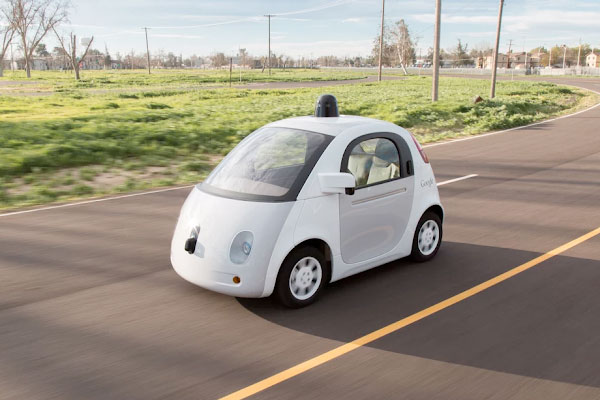
Google’s 2-seat, self-driving car will road test this summer [WATCH]
by Dee-Ann Durbin, The Associated Press

Google says the prototype, with no gas pedal or steering wheel, is the first vehicle built from scratch for the purpose of self-driving
This prototype is the first vehicle built from scratch for the purpose of self-driving, Google says. It looks like a Smart car with a shiny black bowler hat to hide its sensors, and it can drive, brake and recognize road hazards without human intervention. It has more capabilities than the prototype Google introduced last May, which was so rudimentary it had fake headlights.
The new pod isn’t designed for a long trip, or a joyride. It lacks air bags and other federally required safety features, so it can’t go more than 25 miles per hour. It’s electric, and has to be recharged after 80 miles. And the pod can only drive in areas that have been thoroughly mapped by Google.
At first, it will likely even have a steering wheel and gas pedal—current California regulations require them. Those regulations also require a driver to be able to take back control of the car at any time. But Google is lobbying for more flexible regulations.
Google will initially build and test 25 pods, mostly in neighbourhoods surrounding its Mountain View headquarters. It will eventually build between 50 and 100, and will broaden testing to sites that are hillier and rainier.
The ultimate goal, says Google co-founder Sergey Brin, is computer-controlled cars that can eliminate human error, which is a factor in an estimated 90 per cent of the 1.2 million road deaths that occur worldwide each year. Self-driving cars could also improve traffic congestion and transport the elderly and disabled.
Google shocked the auto industry in 2010 with its announcement that it was working on a driverless car. Brin insists Google doesn’t aspire to be a car company, but wants its technology to be adopted by automakers.
“We want to partner to bring self-driving to all the vehicles in the world,” Brin told a group of journalists and community members gathered earlier this week to take rides in the prototype.
For now the traditional automakers are pursuing their own self-driving technology, but with less ambitious timeline of 10 to 15 years for a truly driverless car.
The prototype cars—assembled in suburban Detroit by Roush Industries—have the same array of radars, lasers and cameras as Google’s fleet of Lexus SUVs, which allows them to share data. If one car’s camera spots orange cones and construction signs, for example, it will alert all the others to slow down in that area or reroute around a lane closure.
Dmitri Dolgov, the head of software for the self-driving car project, says Google’s software has gotten much better over the last year at classifying objects like trees and mailboxes, and predicting behaviour of pedestrians and other cars. For example, Google’s cars will slow down if they sense that a car in the next lane is speeding up to cut in front of them. And in one recent test, a Google car paused when a cyclist ran a red light. Another car, driven by a human, went ahead and nearly hit the cyclist.
The system isn’t perfect. On a test drive, one of Google’s Lexus SUVs seemed momentarily confused when a mail truck partially blocked its path. Later, during a demonstration drive in Google’s parking lot, the prototype _ without a wheel or pedal _ braked when it spotted a row of folding chairs. It had to figure out that the chairs wouldn’t move before it proceeded.
Dolgov says it’s impossible to predict everything its test cars might see, so they’re programmed to act in the most conservative way when they confront something unusual, like the time a Google SUV stopped and waited while a woman in a wheelchair chased a duck with a broom.
Egil Juliussen, the principal analyst of infotainment and advanced driver assist systems for the consulting firm IHS Automotive, says Google’s “moon shot” strategy is difficult and riskier than just adding features to existing cars. But he thinks it could ultimately be successful. Google could make self-driving urban pods for universities or urban centres, for example, or sell its technology to automakers.
Here is a video from Google’s blog:
